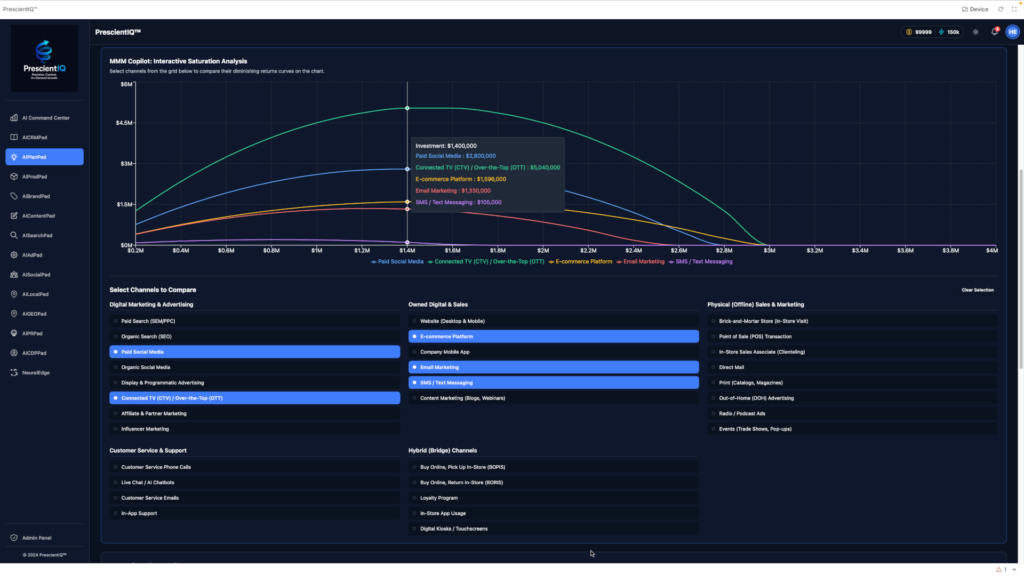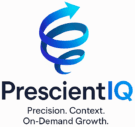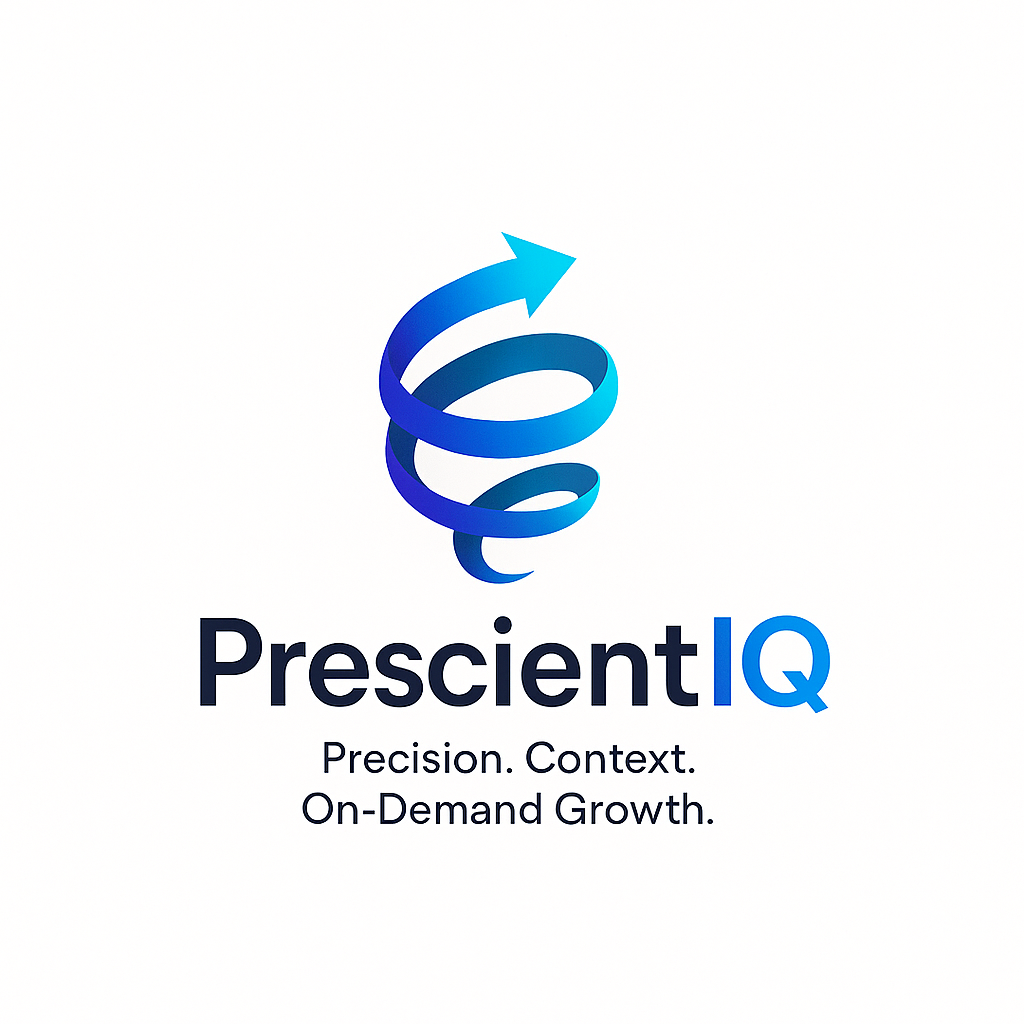Quantum AI Marketing and PrescientIQ: The Future of Predictive Intelligence
Learn about Quantum AI Marketing and PrescientIQ: The Future of Predictive Intelligence.
Executive Summary
Modern marketing is at an inflection point. Data is abundant, analytics are advanced, yet decision-making remains uncertain.
CMOs face the paradox of more information but less clarity. Traditional analytics describe what happened; predictive models estimate what might happen, but few systems can explain why things happen or what to do next.
Enter Quantum AI, Unified Causal Intelligence (UCI), and PrescientIQ — a new triad that fuses causal reasoning, quantum computation, and adaptive intelligence into a unified marketing optimization system.
Supported by the research and methodologies developed at MatrixLabX, this paradigm empowers organizations to move beyond correlation-based analytics toward actionable causality and pre-factual simulation marketing.
The result: smarter resource allocation, quantum-driven personalization, and a fundamentally new understanding of customers as dynamic, probabilistic systems—the Quantum Customer.
Modern Marketing’s Inflection Point
Data is abundant and analytics are advanced—yet clarity is scarce. The new mandate for CMOs: move beyond correlation to causality and pre‑factual foresight.
THE QUANTUM CUSTOMER
Unified Causal Intelligence (UCI)
Explains why outcomes occur and prescribes what to do next. Replaces vanity metrics with causal levers you can pull.
From descriptive to decisiveQuantum AI
Optimizes high‑dimensional decisions—budget, sequence, offer, channel—via quantum‑inspired search and sampling. Finds the value others miss.
Exploration at enterprise scalePrescientIQ
Pre‑factual simulation engine that stress‑tests strategies before you spend. See second‑order effects across the journey.
From predictive to prescient1. The Marketing Optimization Paradox
Despite massive investments in AI-powered marketing automation, martech stacks remain fragmented and reactive.
A 2024 McKinsey report found that while 83 percent of CMOs plan to increase AI investment, only 20 percent believe they can directly tie AI initiatives to revenue outcomes. The missing link is causality.
Traditional analytics tools surface correlations (“email open rates rise with ad spend”) without identifying causal chains (“did increased ad visibility drive email engagement, or vice versa?”). This leads to overspending, false attribution, and a reactive strategy.
George Schildge, CEO of MatrixLabX, puts it succinctly:
“Marketers have become masters at explaining yesterday. The leaders of tomorrow will design tomorrow before it happens. It’s Decision Intelligence.”
To design tomorrow, we need intelligence that understands why things work and can simulate what will work next.
2. From Predictive to Prescriptive: The Rise of Unified Causal Intelligence
Unified Causal Intelligence (UCI) represents a fundamental evolution beyond traditional predictive analytics.
Rather than merely forecasting outcomes, UCI maps the underlying cause-and-effect relationships across marketing, sales, finance, and operations.
UCI integrates:
- Causal inference and graph theory — revealing how specific actions lead to outcomes.
- Counterfactual and pre-factual simulation — asking not only “what would have happened if…” but “what will happen if we do X?”
- Quantum computing principles — enabling simultaneous exploration of millions of causal pathways.
- Adaptive AI agents — systems that act on causal insights in real time.
Gartner predicts that by 2027, organizations using causal and pre-factual models will outperform peers in decision-making accuracy by at least 30 percent. PrescientIQ operationalizes this advantage by embedding UCI directly into the marketing technology stack.
3. Introducing PrescientIQ and MatrixLabX
PrescientIQ, developed in collaboration with MatrixLabX, is not just another marketing AI.
It is a quantum-native causal intelligence system built to unify data, reasoning, and foresight across the enterprise.
PrescientIQ’s architecture includes:
- Causal Graph Engine — constructing unified causal maps across all business functions.
- Quantum-Native Attribution — disentangling the complex interplay of marketing signals and customer behavior.
- Pre-Factual Simulation Core — running “what-if” scenarios across virtual business environments before any real-world action.
- Adaptive Decision Agents — AI entities that continuously learn, optimize, and act within predefined strategic goals.
Instead of analyzing what happened last quarter, PrescientIQ allows CMOs to ask:
- If we reallocate 10 percent of the spend from paid search to retention, what is the probable effect on lifetime value?
- If we launch a new product in Q3, how will it ripple through pricing, inventory, and customer sentiment?
- What future scenarios maximize profit under different economic conditions?
The answers aren’t static predictions — they’re dynamic simulations that evolve as new data arrives.
4. Quantum AI in Marketing: Beyond Classical Computation
To understand why quantum AI matters, it helps to contrast it with classical AI.
Traditional algorithms operate in linear sequences; quantum AI processes information in superposition, evaluating multiple potential realities simultaneously.
In marketing terms:
- A classical AI might test thousands of combinations of creative and targeting over time.
- A quantum-inspired system like PrescientIQ can analyze millions of scenarios in parallel, identifying optimal causal relationships almost instantly.
This enables quantum machine learning for marketing — a new class of models that learn not just patterns but principles. They understand why a message resonates, not just that it did.
McKinsey notes that quantum AI could accelerate optimization tasks by 100x for certain marketing and logistics operations within the decade.
For CMOs, this translates into real-time budget adjustments and campaign designs that adapt as quickly as the market itself.
5. The Power of Pre-Factual Simulation Marketing

Pre-factual simulation marketing turns strategy into a living experiment. Whereas predictive models analyze past data to forecast future probabilities, pre-factual systems simulate future actions and measure their hypothetical effects before implementation.
For example, A CMO considering a 10 percent discount campaign can run a pre-factual simulation to see how it might affect demand, margins, and brand perception across segments. If the simulation shows a negative long-term ROI, the system can suggest alternative actions — perhaps a loyalty bonus instead of a price cut.
PrescientIQ’s pre-factual engine transforms decision-making from reaction to pre-design: marketing strategies are tested in virtual reality before they impact real customers or budgets.
This is not a marketing dashboard. It’s a decision laboratory.
6. Digital Twins and the Quantum Enterprise
One of the most powerful extensions of PrescientIQ is its use of digital twins — virtual replicas of markets, customers, and business systems that learn and adapt in real time.
A digital twin of your marketing ecosystem mirrors the entire customer journey: advertising, sales touchpoints, pricing dynamics, and external influences such as competitors and economic conditions.
Using quantum processing, PrescientIQ creates Quantum Digital Twins that can exist in multiple potential states simultaneously.
When new data enters the system, these probabilities collapse to reveal the most likely outcome — and the most effective action.
The implications are profound:
- CMOs can test pricing strategies across virtual markets before launch.
- Demand forecasts update in real time as variables shift.
- Marketing operations become a living, adaptive system rather than a static plan.
Gartner refers to this as the emergence of digital twin organizations (DTOs), where AI continuously simulates and optimizes enterprise behavior in silico before it occurs in reality.
Quantum Customer
On your site, buyers don’t fit one label. They inhabit multiple potential states—value-seeker, brand‑loyal, convenience‑driven—until the decision moment collapses their journey into reality. Explore the model below.
Superposition: one customer, many potential personas
Click a persona to nudge its likelihood. Then press Collapse Decision to see which state dominates at purchase.
Uncertainty Lab: journeys move, not march
Simulate path variance. Turn the dial, then Measure (reduces variance) or Nudge (pulls toward conversion). Watch the cloud of possible journeys respond.
Entanglement: signals ripple across contexts
When profiles correlate, a lift in one area boosts intent elsewhere (ads ↔ social proof, device A ↔ device B). Try it—watch the link energize and the meters update.
Observation: trust lift in one context raises correlated purchase intent elsewhere. Guard against negative spillover from irrelevant retargeting.
7. The Quantum Customer: A New Model of Behavior
Modern customers defy linear journeys. The linear marketing funnel has been dead for years.
They move fluidly between channels, moods, and moments. Like quantum particles, they occupy many potential states at once — researching, comparing, and deciding simultaneously across devices and contexts.
The Quantum Customer is a metaphor for this non-deterministic behavior. Probabilities shift with each interaction until a purchase moment collapses the journey into reality.
Traditional segmentation cannot capture this fluidity. PrescientIQ models the Quantum Customer as a probabilistic system, where intent is not a fixed attribute but a moving field of possibilities.
In practice, this means marketing systems that can:
- Detect shifts in customer probability fields before conversion signals appear.
- Adapt offers, content, and channel mix in real time based on emerging intent.
- Create quantum-driven personalization that evolves with each interaction.
This dynamic model turns personalization into a living conversation rather than a static rule set.
8. Quantum-Driven Personalization: The Next Frontier

Quantum AI reshapes the idea of personalization from micro-targeting to probabilistic understanding.
Rather than assigning customers to segments, PrescientIQ assigns probability states that represent intent trajectories.
For instance, a Quantum Customer might simultaneously be 70 percent in the “consideration” state and 30 percent in the “purchase-ready” state. As interactions occur, the wavefunction collapses — the customer moves decisively toward conversion.
PrescientIQ uses these signals to deliver content and offers at the exact moment probability peaks. The result is a level of personalization so precise it feels intuitive.
This quantum-driven approach is already reshaping customer engagement models in early enterprise deployments of MatrixLabX systems.
9. Integrating Quantum AI into the CMO Agenda
While the technology sounds futuristic, the path to adoption is practical.
According to Gartner’s 2025 Marketing Technology Roadmap, three priorities define the next wave of enterprise AI integration:
- Data Unified Architecture: Breaking down silos to create a single source of causal truth.
- Explainable AI: Ensuring quantum and causal models are transparent and interpretable to executives.
- Adaptive Automation: Empowering AI agents to act within defined guardrails but learn autonomously.
For CMOs, the strategic imperatives are clear:
- Build the foundation. Audit your data ecosystem for causal readiness — quality inputs drive meaningful simulations.
- Adopt Unified Causal Intelligence. Integrate causal reasoning tools to understand drivers of performance.
- Experiment with Pre-Factual Simulation. Test budget and creative decisions virtually before deployment.
- Develop Quantum Literacy. Train teams on quantum-inspired thinking — probabilities, entanglement, and non-linearity.
10. AI-Powered Marketing Automation Meets Quantum Design

Most current AI-powered marketing automation systems operate as reactive feedback loops: they observe performance and adjust.
Quantum-native systems add a new dimension — they anticipate.
PrescientIQ integrates directly with existing martech tools, acting as a causal control layer on top of CRMs, ad platforms, and content systems.
It can instruct automation engines to shift budget allocation or message timing based on probabilistic forecasts of future behavior.
In effect, it turns marketing automation into marketing orchestration — a self-optimizing system that learns, simulates, and executes in real time.
11. Quantum Computing Applications in Business
Quantum AI’s potential extends far beyond marketing. Enterprises are exploring quantum-enhanced applications in logistics, finance, drug discovery, and climate modelling.
Marketing is emerging as a natural beneficiary because it involves complex, multivariate optimization — exactly the problem quantum systems excel at solving.
Gartner projects that by 2030, nearly 20 percent of Fortune 500 companies will integrate quantum computing into core business workflows. PrescientIQ’s quantum-native design positions brands to capitalize on this shift now rather than later.
12. Real-World Scenario: Causal Optimization in Action
Consider a global retail brand struggling to balance online and offline sales.
Traditional attribution suggested that increasing digital ad spend drove store traffic. Still, causal analysis through PrescientIQ revealed the opposite: local events and in-store promotions boosted online search interest, not the other way around.
By adjusting campaign timing and cross-channel coordination, the brand achieved:
- 27% increase in conversion rate within 3 months.
- 35 percent reduction in wasted ad spend.
- Unified insight across marketing, sales, and supply chain.
This illustrates the core value of causal intelligence: seeing the world as a web of interactions rather than a list of metrics.
13. Ethical and Cultural Considerations
As with any powerful technology, quantum AI raises questions about transparency and control. CMOs must ensure that causal systems remain explainable and aligned with human values.
Gartner emphasizes the need for “ethical AI frameworks that balance autonomy and accountability.”
PrescientIQ addresses this through transparent causal chains — every recommendation is traceable to its underlying logic. Rather than a black box, it is a glass engine of reasoning.
Culturally, this shift demands a new mindset inside marketing organizations: from reporting performance to designing futures from data analysis to decision intelligence.
14. Key Takeaways for Marketing Leaders
- Move Beyond Correlation. Traditional analytics describe, causal intelligence explains, and prescribes.
- Adopt Pre-Factual Thinking. Test before you act — simulate future strategies virtually.
- Model the Quantum Customer. Treat behavior as probabilistic, not deterministic.
- Unify Systems Through Causal Graphs. Connect marketing, operations, and finance into a single decision network.
- Build Digital Twins. Use quantum simulations to forecast ecosystem-wide impacts.
- Empower AI Agents. Let adaptive intelligence execute within strategic boundaries.
- Educate and Evolve. Quantum literacy will become a strategic CMO skillset.
15. The Future of Marketing Technology
The convergence of causal intelligence, quantum computing, and AI heralds the next epoch of marketing — one where decisions are engineered, not guessed.
As George Schildge notes:
“The future of marketing belongs to those who stop predicting and start pre-designing.”
Quantum AI and PrescientIQ are not simply tools; they are strategic catalysts enabling marketers to architect realities rather than react to them.Within this decade, organizations that operationalize Quantum-Driven Marketing Optimization will redefine competitive advantage — not by analyzing the past but by simulating the future.



